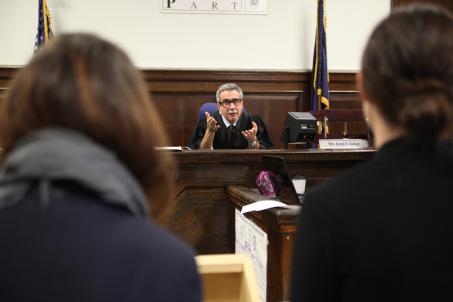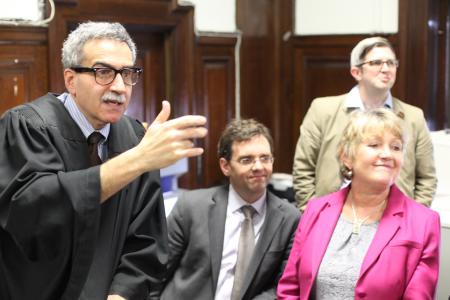Christine H. Lindquist, a senior research sociologist at RTI
International, talks about reentry
courts, recidivism, and what she’s learned so far from a multi-year study funded by the US Department of Justice. April 2013
CHRISTINE LINDQUIST: Reentry courts really have a talent in terms of delivering all of the needed services
to a diverse population.
ROBERT V. WOLF: I’m Rob Wolf, director of communications at the
Center for Court Innovation, and on this New Thinking podcast we’re talking about reentry courts with Christine
Lindquist, a Senior Research Sociologist at RTI International. She just completed the first phase of a multi-year
study of eight reentry courts around the U.S. Welcome to New Thinking, Christine.
LINDQUIST: Thank
you so much for having me.
WOLF: We should be clear about what we mean by the word reentry. So
what is reentry referring to?
LINDQUIST: Reentry refers to the process of a person leaving prison
after incarceration and reintegrating back into their community.
WOLF: You worked on an earlier
evaluation. So I thought maybe we could start off, if you talk a little bit about some of its highlights and how
they may have prepared you for this one.
LINDQUIST: Sure. So the multi-side evaluation of the
Serious and Violent Offender Reentry Initiative, or SVORI, which is a little easier to say, was a large multi-year
evaluation and we looked at recidivism and other outcomes for individuals who received enhanced reentry programming
through SVORI, as well as a comparison group of returning prisoners who received treatment as usual. And basically
in the SVORI evaluation, when we looked at short term effect. And by short term effects we mean recidivism within
two years and then other outcomes such as drug use, employment that we looked at during shorter periods, such as
three months after release, nine months and 15 months. We found some short term effects when looking at some outcomes.
So, for example, for some employment outcomes, people who received enhanced reentry programming did better than those
who received treatment as usual. However, when looking at recidivism, we didn’t really find strong short term
effects. But interestingly, when we looked at longer term recidivism through another grant that we received, we did
find positive effect for recidivism, and by this we mean reductions in arrest, a longer average time to first arrest
following release, and longer time between arrests for the SVORI group compared to those who received treatment as
usual. So I think one thing we learned from the SVORI evaluation is that recidivism effects took longer to observe,
and that suggests the need for longer follow-up in evaluations in order to detect those. And then also we found that
it’s really important not to just assume that all services are helpful. Some services may be more effective
for certain types of prisoners than others. For men, we found that services that promoted individual change – such
as anger management programs, or programs that help with personal relationships, or criminal thinking, were associated
with longer times to first arrest following release. For women, having a case manager and receiving life skills training
were associated with reductions in recidivism. So it just appears that there’s a lot more to be learned about
the effects of different services and that they may be different for men and women.
WOLF: That’s
very interesting. Let’s move on to your current evaluation that you are working on. Now this study focuses on
a particular model called the reentry court. So maybe you could take a moment just to talk about what a reentry court
is?
LINDQUIST: Sure. Reentry court grew out of a larger national movement towards problem solving
courts. And problem solving courts and the drug court model is the most common and well known of these programs,
are courts that combine judicial authority with rehabilitative services. The reentry courts are specialized problem
solving courts specifically focused on recidivism. So they combine judicial oversight, which includes court hearings
in which a returning prisoner would have his or her status reviewed on a regular basis, and if they’re doing
well they would receive praise or other types of rewards, such as advancing through the program. If they’re
not doing well, they would receive graduated sanctions. So it combines this judicial oversight with the provision
of enhanced reentry services.
WOLF: So in the case of a drug court, the ultimate graduated sanction,
if you take it all the way to end would be a jail sentence. In the reentry model, people have already served their
time. So what is, in fact, the leverage that the court has?
LINDQUIST: In almost all of the sites
that are participating in this evaluation, reentry court is established as a condition of supervision. So if someone
isn’t doing well in the reentry court, if they’re not doing what’s expected of them, then the leverage
that the court has is that their supervision would be revoked.
WOLF: And then return to prison,
in other words, because there’s still time on their formal sentence?
LINDQUIST: That’s
right. They could be returned to prison.
WOLF: Well let’s talk about the current study you’re
working on. It’s a collaboration among researchers at your organization, RTI International, which is based in
North Carolina, and NPC Research, which is based in Oregon, and the Center for Court Innovation here in New York.
It’s the first in a series of evaluation that are going to look at what particular aspects of reentry courts?
LINDQUIST: Yeah, it’s actually a single evaluation, but it’s a multi-component evaluation that
includes a process study, an impact study, and a cost effectiveness study. So in the process evaluation, we’re
documenting the start up and ongoing implementation of the eight reentry courts included in the study over several
years in time, looking at what the implementation challenges were, what the context in which the courts are operating
is, what some of the interagency partnerships look like. And then also, as part of our process evaluation, we want
to see what some of the common elements are among the eight programs, to try to see if we can develop a true reentry
court model similar to what we have for drug courts, you know, with the 10 key components. And then for the impact
evaluation, we’re looking at how effective these reentry courts are at reducing recidivism and affecting other
important outcomes. In all eight of the sites, we’re planning on using administrative data to look at rearrests
and reincarceration outcomes, using a masked comparison group design. And then in four of the eight sites, we’re
doing a prospective impact study where we’re interviewing clients who enroll in the reentry court program, and
we’re also interviewing a comparison group of comparable individuals returning from incarceration. And that
allows us to measure employment, family re-integration, community involvement, mental health, substance abuse. And
then we’ll also be able to document personal characteristics that maybe associated with program effects, such
as readiness for change, risk, need for services, and other measures like that. And then finally, we have a cost-effectiveness
analysis where we’re going to be documenting what the costs are of implementing a reentry court, and then also
looking at what the overall cost savings is, if any. So those are the three components of our evaluation, and the
report that we just released is the summary of our first year’s work in the process evaluation.
WOLF:
Given these, that you have eight sites and so many different factors, I mean it seems to me that that’s very
challenging and I wonder if you could talk about some of the challenges of making sense from so much information—eight
different sites, so many different variables.
LINDQUIST: Yeah, the variability is actually not
a problem for the process evaluation. It actually makes it more interesting because we’re really characterizing
how the courts fall on a variety of domains. It’s really interesting to highlight the sources of variability
as opposed to the sources of commonality. What is challenging, though, is for the impact evaluation because when
you have a diverse set of programs, it’s very difficult and often times it’s impossible to pool the data
across the sites. When there’s too much variability, we’re forced to look at site-specific impacts, which
means that effects on recidivism would have to be very large for us to be able to detect those using analytic techniques.
WOLF: What are the most significant findings so far?
LINDQUIST: Well, at this stage I
don’t think we can identify any promising practices or evidence-based practices that seem to be associated with
program effectiveness. What we know so far is that reentry courts are very diverse, unlike drug courts which target
a specific population—people with chemical dependencies. Reentry courts don’t typically target a population
with a specific need, and as a result, reentry courts really have a challenge in terms of delivering all of the needed
services to this diverse population. Another interesting finding, I think, is that you know when reentry courts were
initially conceptualized they were really conceptualized to have a heavy pre-release and post-release component,
such that ideally the person would be identified at the time they were initially sentenced, and that the reentry
court would maintain contact with that person throughout their incarceration. But what’s interesting is that
there really isn’t a major emphasis on pre-release services. A lot of courts don’t have the capacity to
reach in and work with clients while they’re incarcerated. Someone could get sent to prison three hours and
some reentry courts aren’t even sure who is actually going to be coming out on conditional release.
WOLF: You know I’ve really enjoyed hearing about the study and I look forward to seeing it progress.
LINDQUIST: Well thank you. I really enjoyed speaking about our study. We’re excited about our initial
findings and look forward to getting further into this evaluation.
WOLF: Well let me let everyone
know that they can download a copy of the year one study, that’s formal name is the “National Institute
of Justice’s Evaluation of Second Chance Act Adult Reentry Courts – Program Characteristics and Preliminary
Themes from Year One.” And they can download it from our website at www.courtinnovation.org. I’m Rob Wolf,
director of communications at the Center for Court Innovation, and I’ve been speaking with Christine Lindquist,
a Senior Research Sociologist at RTI International. Thank you, everybody, for listening.
Podcast: Play in new window | Download

